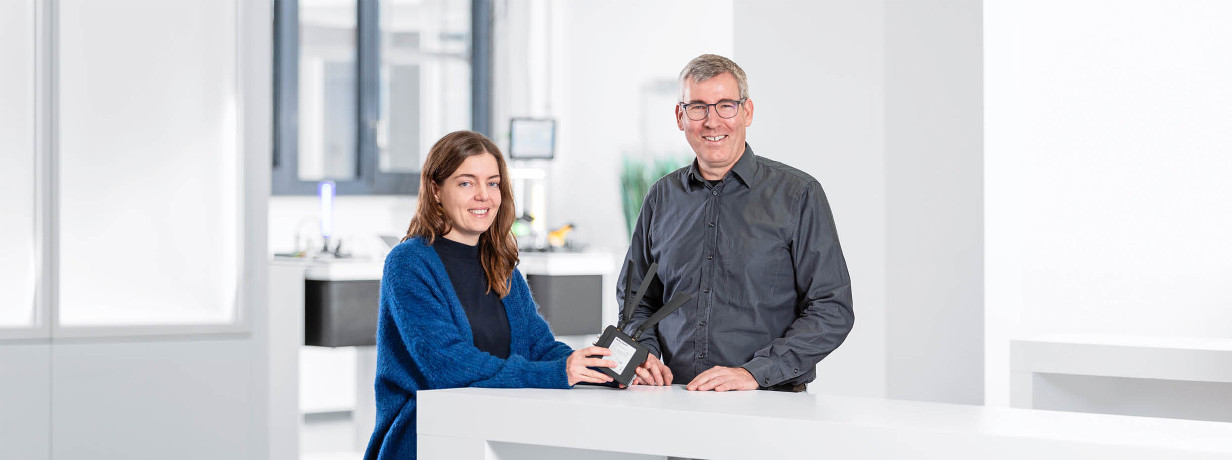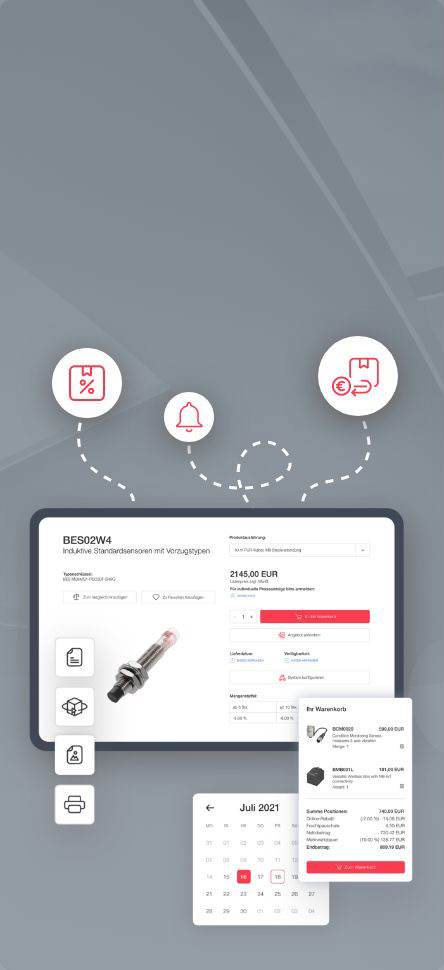09.01.2024
Open to everyone
5G, machine learning, or flexible manufacturing systems—the range of topics covered by current research projects is vast. Freyja Schneider and Albert Dorneich jointly coordinate the research activities at Balluff. In this double interview, they talk about challenges, successes, and how important research is to the company.

You coordinate the research activities at Balluff together. Which qualities do you need for this job?
Freyja Schneider: We share the task. Albert is the point of contact for all things science, new projects, collaborations, or proposals. Once a project has been approved, I provide support with its execution. You definitely need to be curious and communicative, because you always have to deal with new topics, and you need to actively approach people and also openly address issues.
Albert Dorneich: Working where electrical engineering, mechanical engineering, materials science, production engineering, and computer science meet often requires an interdisciplinary way of thinking. You have to be able to live with a certain degree of uncertainty. While research projects do follow a plan, they often change in scope and focus even during their execution phase, or entirely new questions arise.
Freyja Schneider: Additionally, you should be well organized because the job comes with a considerable bureaucratic effort. Applications and accounts need to be submitted, results summarized, and reports written.
Who can work on research projects at Balluff?
Freyja Schneider: Anyone! Research topics and questions can vary greatly. Although many projects come out of the innovation department and product development, we have also had a research project that came out of our HR department. At the moment, we are working on a project in the field of software engineering. Our students and trainees also provide a lot of project content with their final theses and with a high practical component. They build demonstrators, create posters, or attend networking events, for example.
Breaking down silos, cross-company collaboration, practical and at the forefront. That’s genuine collaborative research, which allows the entire value chain to be mapped and the whole system to be considered.
Albert Dorneich, Technology Strategy Manager
Which partners do you work with?
Albert Dorneich: One of our closest research partners is ARENA2036, an innovation platform for mobility, sustainability, and the production of the future. It’s not only the focus that’s a great fit for Balluff, but also the culture. Because the culture of innovation is what makes collaboration at ARENA2036 so special: breaking down silos, cross-company collaboration, practical and at the forefront. That’s genuine collaborative research, which enables the entire value chain to be mapped. No one sits in their ivory tower, instead, everyone comes together at a research campus. Other important research partners in our region are the Fraunhofer Institutes for Manufacturing Engineering and Automation IPA and Industrial Engineering IAO, the Karlsruhe Institute of Technology (KIT), the University of Stuttgart, and Hochschule der Medien (HdM), a university in Stuttgart for applied media studies.
What research questions are you currently working on?
Freyja Schneider: Our colleagues are currently working on various research projects. But if we look at the four most extensive projects, these are Software-Defined Manufacturing for the vehicle and supplier industry, 5G Synergy Region, HoLoDec, and Connect4HCA.
What is so special about these four projects in particular?
Freyja Schneider: In the Software-Defined Manufacturing project, we are using a new method in which we think in terms of software rather than hardware. Just like with solutions from information and communication technology, features that are still unknown at this point are meant to be realized by automatically generated software. This would mean, for example, being able to test a production system virtually by using a digital twin before setting it up in real life. This has enormous advantages, of course.
The topic of software security also plays an important role in this and is of central importance to us. How can software updates or upgrades be carried out in the Balluff products, for example, to increase the resilience of the systems? The strong focus on software is interesting to us because historically, we often think in terms of hardware. We collaborate with Karlsruhe Institute of Technology (KIT), University of Stuttgart, Bosch, Audi, and many more partners on this, and funding came from a government program intended to support innovative companies during the COVID-19 crisis. 5G Synergy Region is another extensive research project, in which ARENA2036, in collaboration with Nokia, runs its own 5G campus, where we develop and test specific 5G applications in an industrial context. Many different partners are involved in this, from the “big players” like Bosch all the way to small startups. But what makes the project special is its focus on real applications and the broad research spectrum: from drone testing above the city of Stuttgart to process optimization in manufacturing or logistics, anything is possible. We evaluate and test communications and localization through 5G to assess ways in which we want to deploy this technology for our own products and customers.
Albert Dorneich: HoLoDec is another interesting project where we focus on the development of wireless sensors that act as nodes in the wireless Internet of Things. There are many industrial applications for this, for example highly mobile robots, in hygiene-critical areas such as the food industry, or for retrofitting. Energy-efficient wireless protocols for data transmission, battery technology for a long service life, and the sensor itself are the focus of this research. How smart does the sensor need to be? Meaning, how much AI and data evaluation are run directly by the microcontroller? Or do we just send the raw data directly to the cloud?
Where will these findings be applied?
Albert Dorneich: One application is the detection of leaks in tanks. Many would prefer to place the sensor under the tank once and then never have anything to do with it again, unless it drips, of course. This makes a service life of more than ten years necessary. These issues are also relevant for our Smart Reordering System in intralogistics or for condition monitoring.
And what is Connect4HCA all about?
Albert Dorneich: HCA is short for human-centered automation, a counter-model to computer-integrated manufacturing (CIM). Manufacturing without humans—an idea that convinced many automation engineers in the 80s. The "perfect" system—shop floors made for machines, without light, because nobody needed to see anything. We at Balluff, however, are convinced that Industry 4.0 is impossible without humans. This is why we are participating in the ARENA2036 project together with the Fraunhofer Institute IAO and other industry partners: we want to find out how humans can best be provided with information in flexible manufacturing. The focus here is on human connectivity with the system. Imagine entering a shop floor and being greeted by a robot, brought up to date and guided across the floor. This requires the collection, transportation, and processing of a huge amount of data and everything has to communicate with everything else. We are focusing heavily on the technical side. Fraunhofer Institute sheds light on the human and ethical aspects.

How does Balluff as a company support employees who are involved in research projects?
Freyja Schneider: Well, there are Albert and me, who provide support from the project outline to its completion. As a company, Balluff provides the means, staff, knowledge, and a well-developed network. Our colleagues perceive the work on research projects as fulfilling.
They use the freedom to organize their work themselves and take deep dives into “their" topics. You also come into contact with completely new questions and people. But publicly funded projects are only one part of the innovation process at Balluff.
What does this process look like in more detail?
Freyja Schneider: The innovation process happens somewhere between trends and customer applicability. From our perspective as an organization, trends reach us from the outside: market trends, new technologies, individual user behavior, or social changes—as a company, we can’t occupy ourselves with everything. This is why we have to monitor these developments, assess them, and make decisions. This is what the Trend to Searchfield Process and the Technology Scouting Framework are for at Balluff. They are tied to individuals. You can apply for various topics and are then provided with time and resources.
As a next step, depending on the situation, we either rely on publicly funded research projects, found an internal startup—a so-called Strategic Incubation Program—which operates as an independent team according to the lean startup method, or we start with a proof of concept.
Does that mean that you don’t pursue every idea or project?
Freyja Schneider: We definitely don’t. Publicly funded projects offer the opportunity to conduct research independently of economic constraints, but Balluff ensures the selected projects fit in well with the corporate strategy.
We have to keep expanding our horizon because companies tend to rest on their laurels. But there is a risk of missing out on new trends because we are too focused on day-to-day business. "Playing it safe" then becomes the guiding principle.
Freyja Schneider, Coordinator Public Funded Projects
How do you deal with a research project not showing the desired potential?
Freyja Schneider: We don’t chalk it up as a failure. That’s important, as that’s the purpose of research projects. We have to keep expanding our horizon because companies tend to rest on their laurels. But there is a risk of missing out on new trends because we are too focused on day-to-day business. "Playing it safe" then becomes the guiding principle. We strive to live a no blame culture, and learning from our mistakes or supposed failures is part of that, of course.
Albert Dorneich: Or we even celebrate them at “f*** up nights”. It is also in the nature of these things that some research projects, especially in fundamental research, do not immediately lead to a finished product. If all new ideas always took off, we would be doing it wrong. The risk of failure is just part of it.
Why is involvement in research so important to Balluff?
Freyja Schneider: Balluff is fully committed to its goal of "innovating automation". We don't just want to adapt technologies, but we want to play an active role in researching them. We can put our own topics on the agenda that are important to our customers. The results are incorporated into the standardization process or sometimes end up as patents. In addition, it is always good to think outside the box. We have a strong internal network, so it goes without saying that we also network with partners in research.

 Products
Products

